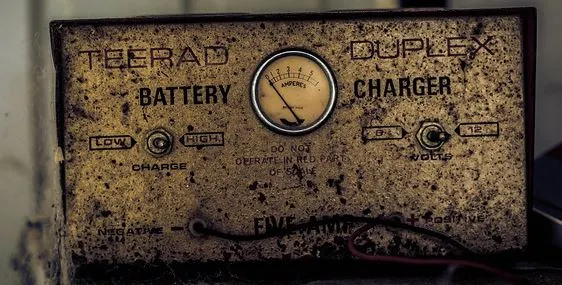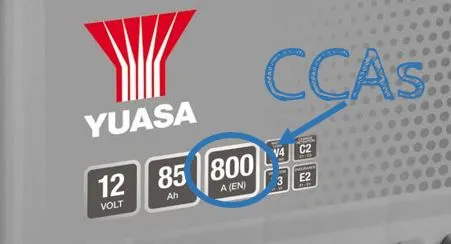
Lithium Engine Starting Batteries – are they a good idea?
Boat owners who have replaced their old Ni-Cd rechargeable drill with a new Lithium-Ion (Li-Ion) model will have been impressed. The increased torque and battery life of the newer technology is great. One of the reasons that Li-Ion batteries perform so well is that the voltage levels stay constant. In Ni-Cd cells, the voltage slowly drops as they discharge. Li-Ion batteries hold at a constant voltage until the battery is nearing full discharge. Have you ever turned on an old torch only to find that the bulb was barely glowing? This happened when the voltage levels in the batteries had fallen away. The result was that the voltage difference across the bulb was too low for it to operate properly. This doesn’t happen with modern Li-Ion batteries. They always seem “punchy”. Well, until they are dead that is. So what about having a Lithium Engine Starting Battery?
This comparison was fresh in my mind last weekend. I was last heaving my lead acid engine cranking battery out of my sailboat for the winter. Could the emerging battery technology make my boat / life / sore back better? Could I get a Lithium Engine Starting Battery and simply replace my existing lead-acid cell?


How much current do I need to start a small marine diesel engine?
Cranking, or starting, a diesel engine requires quite a bit of effort. Ask anyone who has tried to hand-crank an engine without enabling the decompression mechanism. The starter motor has to compress the air in the cylinder by a factor of up to 25:1. Then, it needs to do so in each cylinder and at a speed which allows the engine to start. This, understandably, requires a huge amount of current, especially on a 12 volt system. Different models and sizes of marine diesel engines will require different starting currents but most will require a CCAs (cold cranking amperes) figure in excess of 200 Amps. Beta Marine specify a starting battery capable of delivering CCAs of 450 – 540 Amps for their 20HP and 25HP models, for example. Additionally, you will reduce the available cranking current if you have undersized starter cables. If these are too thin, they add extra resistance to the circuit which effectively reduces starting current.
What are Cold Cranking Amps (CCAs)? Cold Cranking Amperes (CCAs) is a rating used in the battery industry to define a battery’s ability to crank an engine in cold temperatures. It measures how much current (measured in Amperes) a new, fully charged 12V battery could deliver for 30 seconds while maintaining a voltage difference of 7.2V across the terminals in an ambient temperature of 0°F (-18°C).

Can I Replace my Lead-Acid Cranking Battery with Lithium-Ion?
The short answer is that it’s going to be difficult. Lithium Ion batteries are not suitable as marine diesel starting batteries as they are not capable of delivering enough Cold Cranking Amps to start a typical 25 – 30 HP sailboat engine.
A phrase popularized during the great war described the life of a infantry-man thus; “months of boredom punctuated by moments of extreme terror.” The life of a diesel engine starting battery is in many ways the same. Your starting battery, unlike your leisure batteries, sits unused and absorbs trickle charging from your charge controller from wind, sun and the engine. Then, at the push of a button, we dump as much current as it can provide to the starter motor for a few seconds before letting it recover for another long while.
Lead-acid battery technology is not only relatively inexpensive, it also happens to be ideal for this role. Lead-acid batteries are just better at delivering a high CCA than Lithium Ion cells. That is why automobile makers have not moved over to Lithium batteries for engine starting. When we need light-weight batteries in cars we use gel. They still have drawbacks. They loose charge as they sit idle. They must not be over drained. They are still quite heavy. But they can provide a real punch when needed. While a modern, expensive LiFePO4 battery might deliver around 200 CCA, a fairly standard 100AH car lead acid car battery will deliver in excess of 800 CCA. Lithium has many, many advantages over lead acid in many applications, but cranking your small marine diesel engine is just not one of them.
Why are Marine grade Lithium Ion batteries so expensive?
So, I hear you ask. If marine grade lithium batteries are lighter and smaller than lead-acid, then why are they so expensive? We’re used to everything marine being 2x in price, but even non-marine settings, manufacturers charge plenty for Li-Ion batteries. And yes, pun intended.
It turns out that it isn’t the price of Lithium. Despite the requirements of the seismic shift in the automotive industry towards electric vehicles, lithium prices remain stable and low. In fact, according to research published by Carnegie Mellon University, even if lithium were made completely free today, the price to produce the battery would only fall by about 3%. It’s the cost of Cobalt (which acts as the cathode in these batteries) which keeps the unit price high. The world’s supply of cobalt more or less all comes from the Democratic Republic of Congo and, for a commodity, the prices really move around when supply chain issues arise. So, until cobalt prices stabilise, and reduce, expect Li-Ion battery prices to remain high.


What are the pros and cons of lithium ion batteries?
Lithium Ion batteries clearly have some advantages and disadvantages as a power source on a family sailboat. Let’s consider the pros and the cons.
Advantages of Li-Ion Batteries in Boats
- Discharge level can go right down to below 10% without damaging the battery
- The number of guarenteed charge cycles will be very high – very useful for cruisers
- Voltage output is almost constant for much of the discharge cycle
Disadvantages of Li-Ion Batteries in Boats
- Cost per AH (amp-hour) is very high when compared to lead-acid or AGM batteries
- Li-Ion batteries are not suitable for cranking small diesel marine engines
What is better for house batteries: lead-acid or lithium?
Lithium battery technology does have a place on a sailboat. Li-Ion cells make better house batteries than starter batteries. When you’re spending an evening at anchor, or at a dock without power hook-up, your batteries will need to keep you going all night. Whether you’re running your lights, instruments, AC, heating or entertainment system you’ll either need a house bank with enormous capacity or batteries that can tolerate a fair amount of discharge. Regular lead-acid batteries can only be discharged by up to 50% before irreversible damage occurs. Even “deep cycle leisure” lead-acid batteries can only be safely discharged to 50%. This is obviously a problem for house banks unless you really enjoy the sound of a generator while watching the sun set.
Lithium-ion cells will supply nearly all of the stated battery capacity. With exception of the last 3% or so of remaining capacity, you can use it all. This effectively allows you to halve the amp-hour capacity of your bank over lead-acid. This is a tremendous weight and space saving opportunity of your sailboat.
Can I mix an lead-acid battery with a lithium battery in my bank?
Do not be tempted to upgrade just one of the batteries in your house bank to Li-Ion and leave the rest as they are. Mixing lead-acid and Lithium batteries in parallel without some clever electronics can cause permanent damage to the batteries. It can even cause a fire. Do not attempt this unless you really know what you’re doing.
